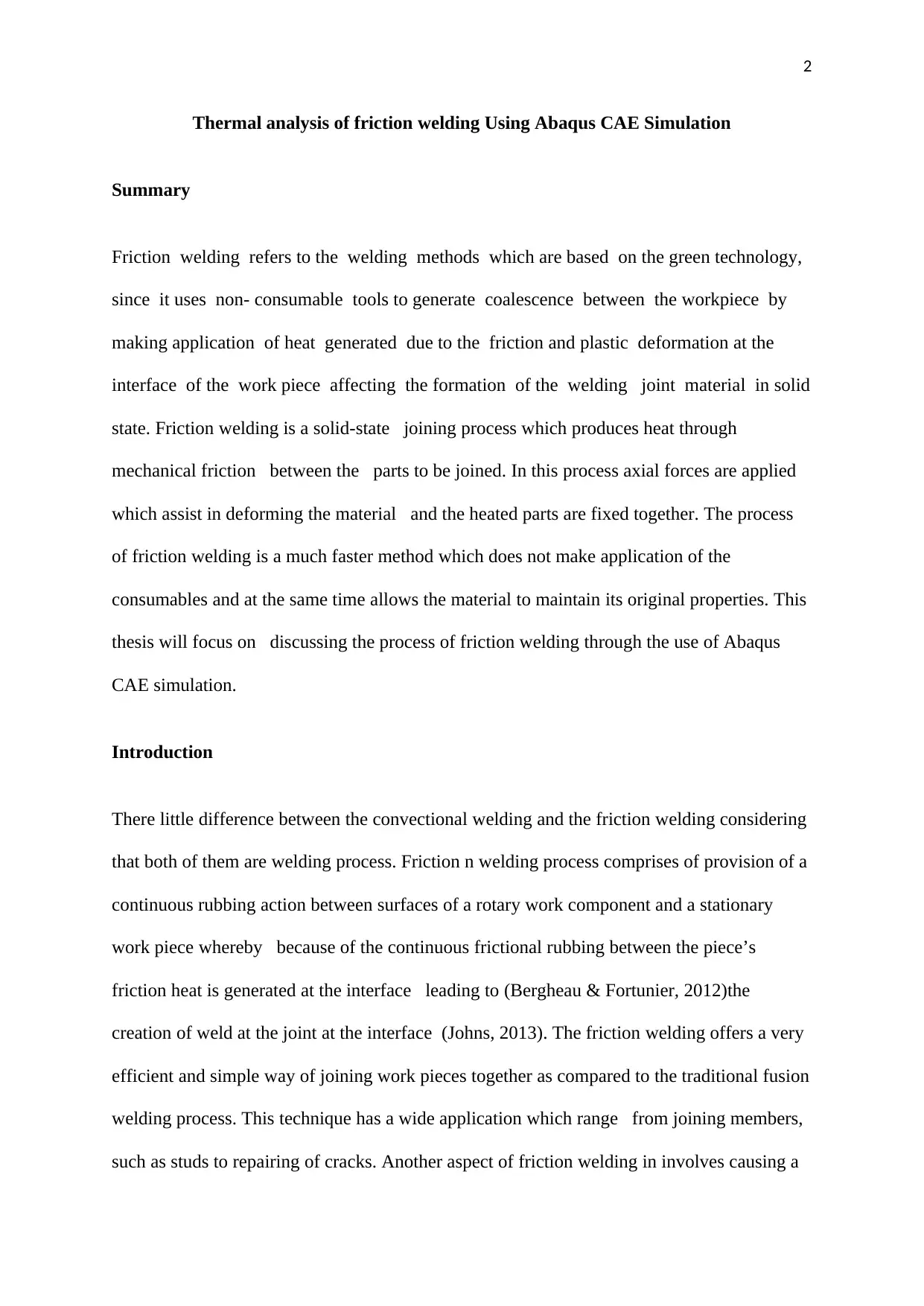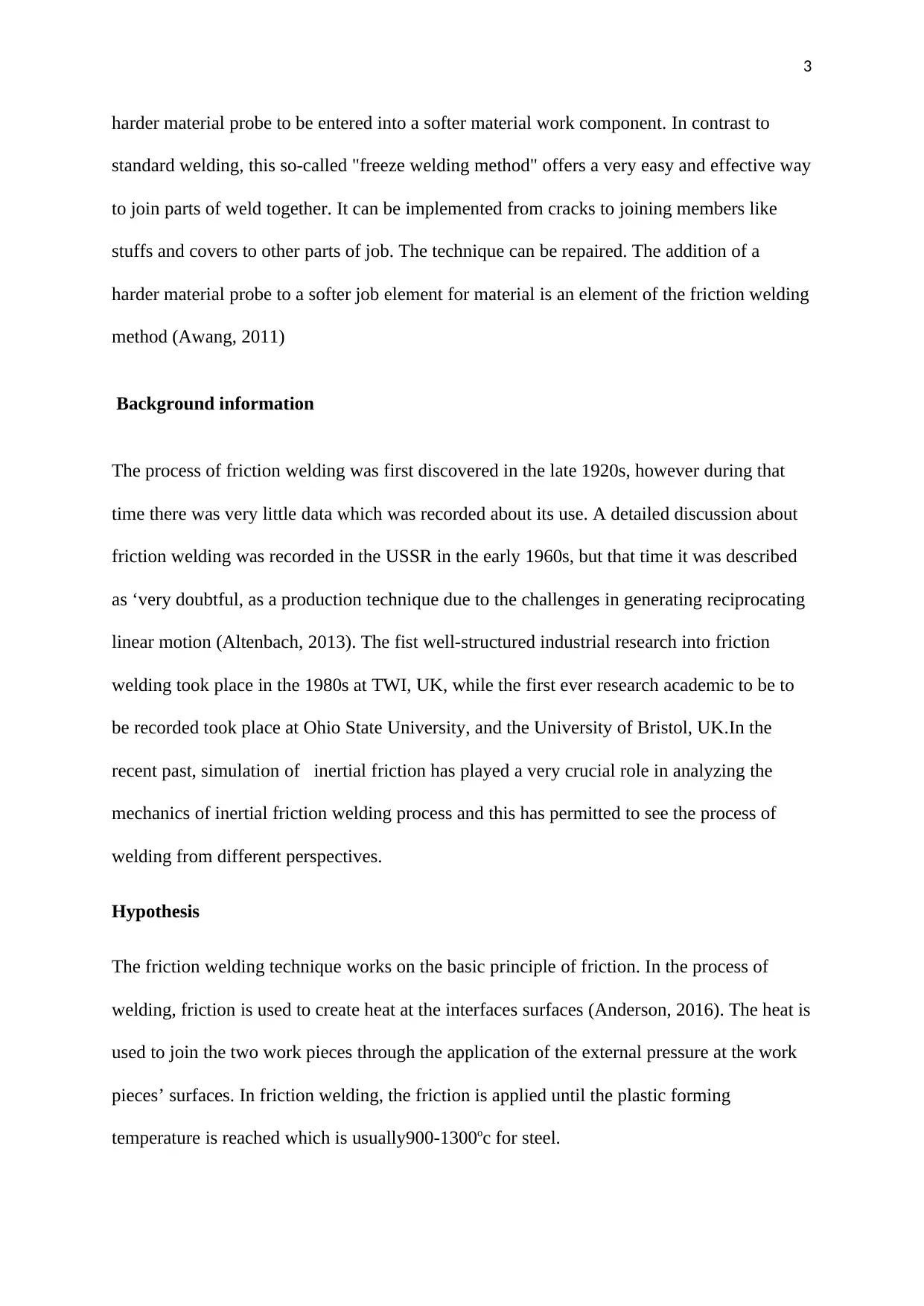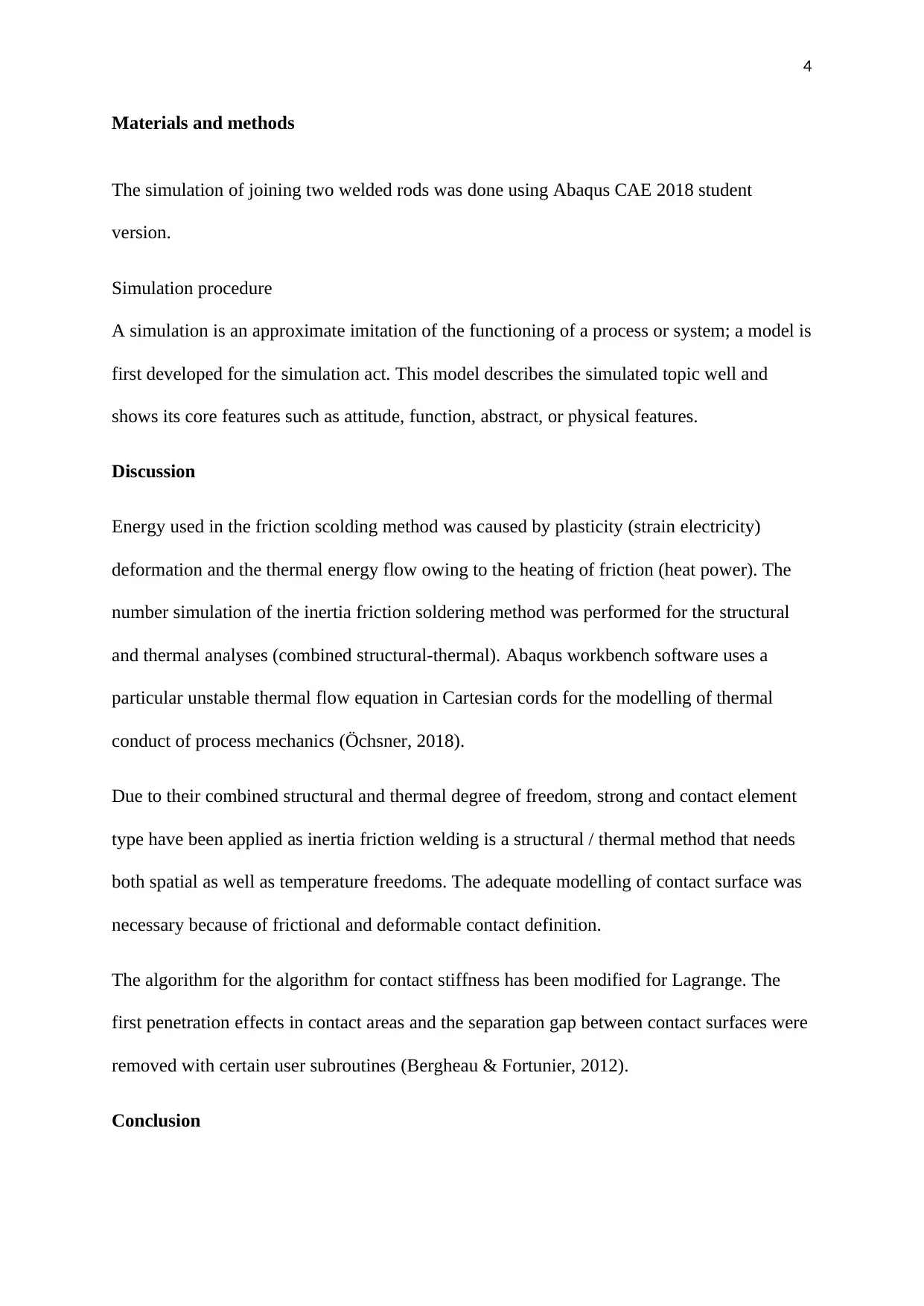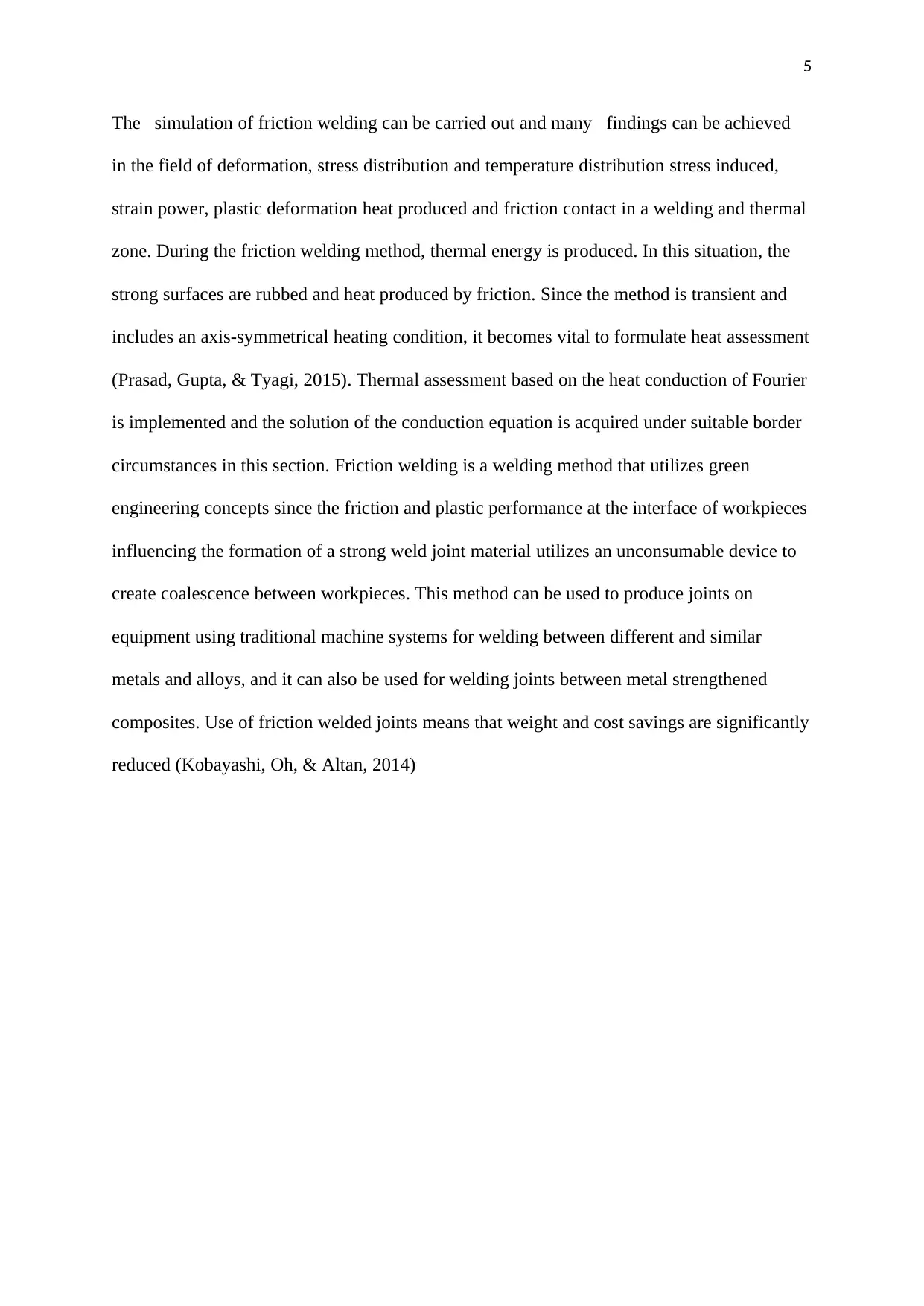Thermal Analysis of Friction Welding Using Abaqus CAE Simulation
VerifiedAdded on 2022/09/17
|6
|1296
|33
Report
AI Summary
This report presents a thermal analysis of friction welding, a solid-state joining technique, using Abaqus CAE simulation. The study begins with an introduction to friction welding, its advantages, and its applications, particularly in industries like aerospace and automotive. It explains the process of friction welding, which involves generating heat through friction and plastic deformation at the interface of workpieces. The report discusses the simulation procedure, including the use of Abaqus CAE 2018 student version, and details the modeling of structural and thermal analyses. The study highlights the importance of contact surface modeling and the implementation of algorithms to address penetration effects. The findings cover deformation, stress distribution, and temperature distribution. The conclusion emphasizes the efficiency of friction welding and its benefits in terms of weight and cost savings. The report also includes references to relevant research papers.

1
RESEARCH METHODOLOGY THESIS
By Name
Course
Instructor
Institution
Location
Date
RESEARCH METHODOLOGY THESIS
By Name
Course
Instructor
Institution
Location
Date
Paraphrase This Document
Need a fresh take? Get an instant paraphrase of this document with our AI Paraphraser

2
Thermal analysis of friction welding Using Abaqus CAE Simulation
Summary
Friction welding refers to the welding methods which are based on the green technology,
since it uses non- consumable tools to generate coalescence between the workpiece by
making application of heat generated due to the friction and plastic deformation at the
interface of the work piece affecting the formation of the welding joint material in solid
state. Friction welding is a solid-state joining process which produces heat through
mechanical friction between the parts to be joined. In this process axial forces are applied
which assist in deforming the material and the heated parts are fixed together. The process
of friction welding is a much faster method which does not make application of the
consumables and at the same time allows the material to maintain its original properties. This
thesis will focus on discussing the process of friction welding through the use of Abaqus
CAE simulation.
Introduction
There little difference between the convectional welding and the friction welding considering
that both of them are welding process. Friction n welding process comprises of provision of a
continuous rubbing action between surfaces of a rotary work component and a stationary
work piece whereby because of the continuous frictional rubbing between the piece’s
friction heat is generated at the interface leading to (Bergheau & Fortunier, 2012)the
creation of weld at the joint at the interface (Johns, 2013). The friction welding offers a very
efficient and simple way of joining work pieces together as compared to the traditional fusion
welding process. This technique has a wide application which range from joining members,
such as studs to repairing of cracks. Another aspect of friction welding in involves causing a
Thermal analysis of friction welding Using Abaqus CAE Simulation
Summary
Friction welding refers to the welding methods which are based on the green technology,
since it uses non- consumable tools to generate coalescence between the workpiece by
making application of heat generated due to the friction and plastic deformation at the
interface of the work piece affecting the formation of the welding joint material in solid
state. Friction welding is a solid-state joining process which produces heat through
mechanical friction between the parts to be joined. In this process axial forces are applied
which assist in deforming the material and the heated parts are fixed together. The process
of friction welding is a much faster method which does not make application of the
consumables and at the same time allows the material to maintain its original properties. This
thesis will focus on discussing the process of friction welding through the use of Abaqus
CAE simulation.
Introduction
There little difference between the convectional welding and the friction welding considering
that both of them are welding process. Friction n welding process comprises of provision of a
continuous rubbing action between surfaces of a rotary work component and a stationary
work piece whereby because of the continuous frictional rubbing between the piece’s
friction heat is generated at the interface leading to (Bergheau & Fortunier, 2012)the
creation of weld at the joint at the interface (Johns, 2013). The friction welding offers a very
efficient and simple way of joining work pieces together as compared to the traditional fusion
welding process. This technique has a wide application which range from joining members,
such as studs to repairing of cracks. Another aspect of friction welding in involves causing a

3
harder material probe to be entered into a softer material work component. In contrast to
standard welding, this so-called "freeze welding method" offers a very easy and effective way
to join parts of weld together. It can be implemented from cracks to joining members like
stuffs and covers to other parts of job. The technique can be repaired. The addition of a
harder material probe to a softer job element for material is an element of the friction welding
method (Awang, 2011)
Background information
The process of friction welding was first discovered in the late 1920s, however during that
time there was very little data which was recorded about its use. A detailed discussion about
friction welding was recorded in the USSR in the early 1960s, but that time it was described
as ‘very doubtful, as a production technique due to the challenges in generating reciprocating
linear motion (Altenbach, 2013). The fist well-structured industrial research into friction
welding took place in the 1980s at TWI, UK, while the first ever research academic to be to
be recorded took place at Ohio State University, and the University of Bristol, UK.In the
recent past, simulation of inertial friction has played a very crucial role in analyzing the
mechanics of inertial friction welding process and this has permitted to see the process of
welding from different perspectives.
Hypothesis
The friction welding technique works on the basic principle of friction. In the process of
welding, friction is used to create heat at the interfaces surfaces (Anderson, 2016). The heat is
used to join the two work pieces through the application of the external pressure at the work
pieces’ surfaces. In friction welding, the friction is applied until the plastic forming
temperature is reached which is usually900-1300oc for steel.
harder material probe to be entered into a softer material work component. In contrast to
standard welding, this so-called "freeze welding method" offers a very easy and effective way
to join parts of weld together. It can be implemented from cracks to joining members like
stuffs and covers to other parts of job. The technique can be repaired. The addition of a
harder material probe to a softer job element for material is an element of the friction welding
method (Awang, 2011)
Background information
The process of friction welding was first discovered in the late 1920s, however during that
time there was very little data which was recorded about its use. A detailed discussion about
friction welding was recorded in the USSR in the early 1960s, but that time it was described
as ‘very doubtful, as a production technique due to the challenges in generating reciprocating
linear motion (Altenbach, 2013). The fist well-structured industrial research into friction
welding took place in the 1980s at TWI, UK, while the first ever research academic to be to
be recorded took place at Ohio State University, and the University of Bristol, UK.In the
recent past, simulation of inertial friction has played a very crucial role in analyzing the
mechanics of inertial friction welding process and this has permitted to see the process of
welding from different perspectives.
Hypothesis
The friction welding technique works on the basic principle of friction. In the process of
welding, friction is used to create heat at the interfaces surfaces (Anderson, 2016). The heat is
used to join the two work pieces through the application of the external pressure at the work
pieces’ surfaces. In friction welding, the friction is applied until the plastic forming
temperature is reached which is usually900-1300oc for steel.
⊘ This is a preview!⊘
Do you want full access?
Subscribe today to unlock all pages.

Trusted by 1+ million students worldwide

4
Materials and methods
The simulation of joining two welded rods was done using Abaqus CAE 2018 student
version.
Simulation procedure
A simulation is an approximate imitation of the functioning of a process or system; a model is
first developed for the simulation act. This model describes the simulated topic well and
shows its core features such as attitude, function, abstract, or physical features.
Discussion
Energy used in the friction scolding method was caused by plasticity (strain electricity)
deformation and the thermal energy flow owing to the heating of friction (heat power). The
number simulation of the inertia friction soldering method was performed for the structural
and thermal analyses (combined structural-thermal). Abaqus workbench software uses a
particular unstable thermal flow equation in Cartesian cords for the modelling of thermal
conduct of process mechanics (Öchsner, 2018).
Due to their combined structural and thermal degree of freedom, strong and contact element
type have been applied as inertia friction welding is a structural / thermal method that needs
both spatial as well as temperature freedoms. The adequate modelling of contact surface was
necessary because of frictional and deformable contact definition.
The algorithm for the algorithm for contact stiffness has been modified for Lagrange. The
first penetration effects in contact areas and the separation gap between contact surfaces were
removed with certain user subroutines (Bergheau & Fortunier, 2012).
Conclusion
Materials and methods
The simulation of joining two welded rods was done using Abaqus CAE 2018 student
version.
Simulation procedure
A simulation is an approximate imitation of the functioning of a process or system; a model is
first developed for the simulation act. This model describes the simulated topic well and
shows its core features such as attitude, function, abstract, or physical features.
Discussion
Energy used in the friction scolding method was caused by plasticity (strain electricity)
deformation and the thermal energy flow owing to the heating of friction (heat power). The
number simulation of the inertia friction soldering method was performed for the structural
and thermal analyses (combined structural-thermal). Abaqus workbench software uses a
particular unstable thermal flow equation in Cartesian cords for the modelling of thermal
conduct of process mechanics (Öchsner, 2018).
Due to their combined structural and thermal degree of freedom, strong and contact element
type have been applied as inertia friction welding is a structural / thermal method that needs
both spatial as well as temperature freedoms. The adequate modelling of contact surface was
necessary because of frictional and deformable contact definition.
The algorithm for the algorithm for contact stiffness has been modified for Lagrange. The
first penetration effects in contact areas and the separation gap between contact surfaces were
removed with certain user subroutines (Bergheau & Fortunier, 2012).
Conclusion
Paraphrase This Document
Need a fresh take? Get an instant paraphrase of this document with our AI Paraphraser

5
The simulation of friction welding can be carried out and many findings can be achieved
in the field of deformation, stress distribution and temperature distribution stress induced,
strain power, plastic deformation heat produced and friction contact in a welding and thermal
zone. During the friction welding method, thermal energy is produced. In this situation, the
strong surfaces are rubbed and heat produced by friction. Since the method is transient and
includes an axis-symmetrical heating condition, it becomes vital to formulate heat assessment
(Prasad, Gupta, & Tyagi, 2015). Thermal assessment based on the heat conduction of Fourier
is implemented and the solution of the conduction equation is acquired under suitable border
circumstances in this section. Friction welding is a welding method that utilizes green
engineering concepts since the friction and plastic performance at the interface of workpieces
influencing the formation of a strong weld joint material utilizes an unconsumable device to
create coalescence between workpieces. This method can be used to produce joints on
equipment using traditional machine systems for welding between different and similar
metals and alloys, and it can also be used for welding joints between metal strengthened
composites. Use of friction welded joints means that weight and cost savings are significantly
reduced (Kobayashi, Oh, & Altan, 2014)
The simulation of friction welding can be carried out and many findings can be achieved
in the field of deformation, stress distribution and temperature distribution stress induced,
strain power, plastic deformation heat produced and friction contact in a welding and thermal
zone. During the friction welding method, thermal energy is produced. In this situation, the
strong surfaces are rubbed and heat produced by friction. Since the method is transient and
includes an axis-symmetrical heating condition, it becomes vital to formulate heat assessment
(Prasad, Gupta, & Tyagi, 2015). Thermal assessment based on the heat conduction of Fourier
is implemented and the solution of the conduction equation is acquired under suitable border
circumstances in this section. Friction welding is a welding method that utilizes green
engineering concepts since the friction and plastic performance at the interface of workpieces
influencing the formation of a strong weld joint material utilizes an unconsumable device to
create coalescence between workpieces. This method can be used to produce joints on
equipment using traditional machine systems for welding between different and similar
metals and alloys, and it can also be used for welding joints between metal strengthened
composites. Use of friction welded joints means that weight and cost savings are significantly
reduced (Kobayashi, Oh, & Altan, 2014)

6
References
Altenbach, H. (2013). The Advances in Joining Technology. Berlin: Springer,.
Awang, M. (2011). 2nd International Conference on Mechanical, Manufacturing and
Process Plant Engineering. London: Mokhtar Awang.
Bergheau, J.-M., & Fortunier, R. (2012). Finite Element Simulation of Heat Transfer.
Sydney: PHI Learning Pvt. Ltd.
Johns, J. (2013). Thermal Stress Analyses. Chicago: Elsevier,.
Kobayashi, S., Oh, S.-I., & Altan, T. (2014). Metal Forming and the Finite-Element Method.
London: Oxford University Press.
Öchsner, A. (2018). Improved Performance of Materials: Design and Experimental
Approaches. Chicago: PHI Learning Pvt. Ltd.
Prasad, A., Gupta, S. S., & Tyagi. (2015). Advances in Engineering Design: Select
Proceedings o. 2024: Springer.
References
Altenbach, H. (2013). The Advances in Joining Technology. Berlin: Springer,.
Awang, M. (2011). 2nd International Conference on Mechanical, Manufacturing and
Process Plant Engineering. London: Mokhtar Awang.
Bergheau, J.-M., & Fortunier, R. (2012). Finite Element Simulation of Heat Transfer.
Sydney: PHI Learning Pvt. Ltd.
Johns, J. (2013). Thermal Stress Analyses. Chicago: Elsevier,.
Kobayashi, S., Oh, S.-I., & Altan, T. (2014). Metal Forming and the Finite-Element Method.
London: Oxford University Press.
Öchsner, A. (2018). Improved Performance of Materials: Design and Experimental
Approaches. Chicago: PHI Learning Pvt. Ltd.
Prasad, A., Gupta, S. S., & Tyagi. (2015). Advances in Engineering Design: Select
Proceedings o. 2024: Springer.
⊘ This is a preview!⊘
Do you want full access?
Subscribe today to unlock all pages.

Trusted by 1+ million students worldwide
1 out of 6
Your All-in-One AI-Powered Toolkit for Academic Success.
+13062052269
info@desklib.com
Available 24*7 on WhatsApp / Email
![[object Object]](/_next/static/media/star-bottom.7253800d.svg)
Unlock your academic potential
Copyright © 2020–2025 A2Z Services. All Rights Reserved. Developed and managed by ZUCOL.
